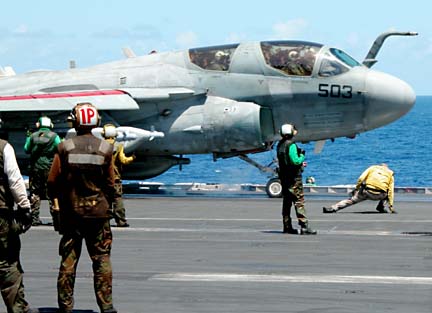
GREGG K. KAKESAKO / GKAKESAKO@STARBULLETIN.COM
An EA-6B Prowler hooked up to a catapult as it prepared to be launched from the flight deck of the USS Abraham Lincoln yesterday. The jets were used in Iraq to jam enemy radar.
Warship’s long
mission nears endThe USS Abraham Lincoln will dock
at Pearl Harbor on the way to its home port
ABOARD THE USS ABRAHAM LINCOLN >> Not wanting to jinx their long mission right before it ends, the crew of this aircraft carrier prefers not to dwell on what their skipper calls "an incredible accomplishment."
The 95,000-ton warship has been at sea for 280 days and has survived three dangerous wartime operations without a loss of life or aircraft, despite having 16,500 sorties flown by 100 aviators piloting F-14 and F-18 Super Hornet combat jets.
Capt. Kendall Card, the Lincoln's skipper, said his No. 1 goal was "to bring everybody and every aircraft home, and we're doing that. So I would say we were extremely successful."
On its way home to Everett Naval Station in Washington, the Lincoln was headed yesterday toward Pearl Harbor where it is scheduled to dock today for a 24-hour layover before starting its final leg home.
The Lincoln battle group, which included Pearl Harbor-based destroyer USS Paul Hamilton and frigate USS Reuben James, participated in the war against Afghanistan and flew Southern Watch surveillance missions over Iraq before the war began last month.
Once the war started on March 20, the Lincoln carried out combat operations for 17 days.
"It was a lot like what we trained for," said Lt. Bill "T-Bone" Gregory, an F-14 Tomcat pilot, as he prepared for flight operations yesterday about 50 miles west of Oahu. "It was exciting, but we were ready for what we saw there."
During the Iraq war, Lincoln warbirds dropped 1.6 million pounds of bombs and rockets. In last year's Afghanistan and "Southern Watch" campaigns over Iraq, the Lincoln unleashed 265,118 pounds of ordnance.
The nuclear carrier will make history next week when President Bush flies out from San Diego to spend a night. Bush is expected to use the Lincoln to declare an official end to the combat in Iraq on Thursday.
The carrier, which left Everett on July 20, will have been at sea longer than any aircraft carrier in the Navy over the last 30 years by the time it docks at Everett on May 6.
Arleen Pauole, a 1999 Castle High School graduate now serving on the Lincoln, said she is looking forward to "being able to sleep in my own bed, eat whenever and whatever I want to without having to stand in line, and standing outside my house just to see the sun."
Pauole, 22, said she feels proud "to have been part of the latest Iraqi effort knowing we were the first battle group there and to know we were ready for anything that Iraq had up its sleeves."
Gilbert Roque, a 1982 Castle High School graduate, said this has been the longest deployment in his 19 years in the Navy.
"I feel that giving the Iraqis their long-awaited freedom is a good thing," said Roque, 38. "Watching them on television while we were launching air supports was a good feeling that soon they will know freedom that would allow them to express their feelings and opinions and a pick a regime that would allow them to have a better economy and better living lifestyles."
Both Card and Capt. Kevin Albright, commander of Carrier Air Wing 14, cited the desert storms, which stopped combat field operations for nearly three days a week after the war began, as the most difficult aspect of the war.
"It was the shifting winds and sandstorms," said Card. "Sometimes these pilots landed with visibility between a sixteenth and an eighth of a mile."
Hawaii military links and information
